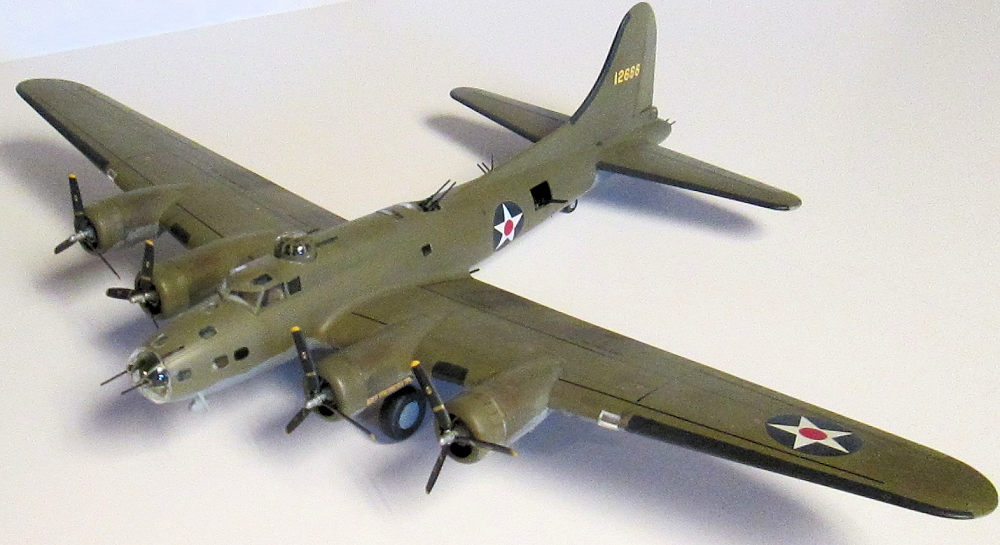
Academy 1/72 B-17E “Pacific Theater”
| KIT #: | 12533 |
| PRICE: | $32.00 |
| DECALS: | Three options |
| REVIEWER: | Dave Cummings |
| NOTES: | Aftermarket bits: Master Model 1/72 .50 barrels (AM72125), Warbirds Decals 1/72 B-17 ID&Lettering (Yello WBS 172006) |

| HISTORY |
Even after a lifetime studying WWII history and the heroic exploits of our servicemen, I am sometimes newly amazed. A couple years ago I had the opportunity to talk to Dick Cole (Jimmy Doolittles Co-Pilot, he was 96 and sharp as a tack). I asked him if, after learning they would have to fly much farther than planned, knowing they had little chance of making it to their landing strip, if he considered it a suicide mission. He was emphatic, no, he said he had the utmost faith in COL Doolittle and believed he would bring them through no matter the odds. Such is the power of faith in a good leader.
I recently read a new (copyright 2016) book,
Lucky 666, about Jay Zeamer and crew who flew the most harrowing combat
mission of WWII. An amazing exploit that became the most highly decorated single
combat mission of the war earning two Medals of Honor (one posthumous) and the
rest of the crew the nation’s second highest honor, the Distinguished Service
Cross. Zeamer was one of the pre-war trained pilots thrust into the desperate
early years of the war. He was a good pilot, but did not suffer Army red tape well and got a reputation as a bit of a rebel. Because of this he was not
recommended for his Command Pilot wings and remained co-pilot to even some
pilots more junior than he. In New Guinea early 1943 he put together his own
crew from kindred spirits found among 43rd Bomb Group personnel. They
volunteered for the most hazardous missions that other crews were glad to pass
on. It was tough sledding in 1942-43 in the Pacific. Those operating from New
Guinea faced the Lae Wing with some of the best pilots in the Japanese Navy. So
leadership accepted some degree of rebelliousness among the hard fighting
aircrews.
well and got a reputation as a bit of a rebel. Because of this he was not
recommended for his Command Pilot wings and remained co-pilot to even some
pilots more junior than he. In New Guinea early 1943 he put together his own
crew from kindred spirits found among 43rd Bomb Group personnel. They
volunteered for the most hazardous missions that other crews were glad to pass
on. It was tough sledding in 1942-43 in the Pacific. Those operating from New
Guinea faced the Lae Wing with some of the best pilots in the Japanese Navy. So
leadership accepted some degree of rebelliousness among the hard fighting
aircrews.
So Zeamer had a crew and a reputation, but he still did not have his own plane. Off the end of a dusty New Guinea airstrip sat an abandoned B-17. It was an older E model that by 1943 had been mostly replaced by the new Fs. It was a “hanger queen” raided for parts by needy crew chiefs. The only reason it was still there was because it was a very special B-17. It was one of two specially equipped with K-17 trimetrogon photo-mapping cameras assigned to the 8th Reconnaissance Squadron. For reasons unknown the 8th had passed it on to the 43rd BG where it was grounded. It had gained a reputation as a “hard luck” ship that managed to limp back from every mission all shot up. The tail number, 666, may have contributed to it being shunned as jinxed due to the biblical connotation, but that is just speculation. But it was a B-17, and it was unassigned. Zeamer was in love and got permission to refurbish it. There was little support available from the hard pressed maintenance section so Zeamer and crew set about getting the plane airworthy themselves.
Jay Zeamer had developed his own theory of
defensive tactics against the Japanese Zeros. The Japanese had developed a
healthy respect for the tough and well-armed Flying Fortress. Like their German
allies they had learned the best way to attack the big Boeing was head on. The
nose offered the weakest defensive armament and an unobstructed shot at the
cockpit. In the course of many missions through 1942 Zeamer had learned to “dog
fight” the Zeros. As they came in their pursuit curve toward his nose Zeamer
learned to time it for making a steep turn toward the enemy fighter. This made
the enemy pilot have to steepen his turn and shortened the time he had to fire
before climbing or diving to avoid collision. This threw off the enemy pilots
timing and caused him to sometimes have to pull up instead of rolling into a
dive. Pulling up gave the bomber’s gunners a good target. Most other 43rd
pilots considered Zeamer a showoff for not flying by the book. Zeamer set about
modifying 666 to suit his unorthodox methods. After replacing all the engines
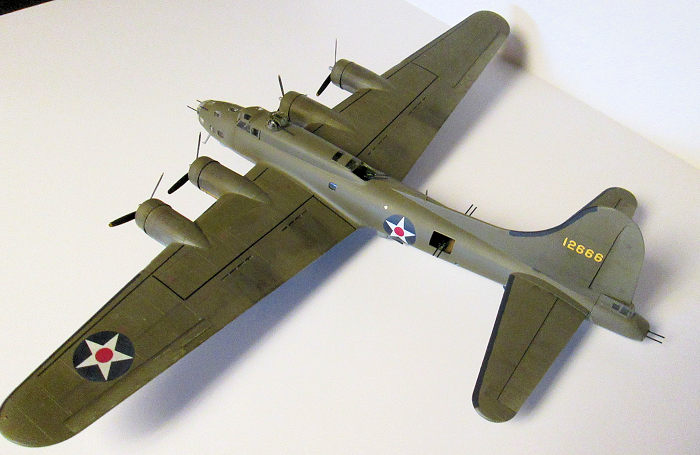 Zeamer had every non-essential piece and part in the plane ripped out, even the
crew’s relief tubes. He estimated they took a ton of weight off the bird. The
weight savings was offset by the addition of more armament. The .30 cal in the
nose of the B-17E was replaced with a pair of .50s. The single .30 manned by the
radio operator was replaced with a brace of 50 calibers. Likewise the waist guns
were modified with mounts for twin .50s. A hole was cut into the belly in front
of the tail wheel for another machinegun. Finally, Zeamer had his own gun fixed
in the nose where it could be loaded by the navigator and fired with a button on
his steering wheel. He called it his “snozzola gun.” There was no sight so
Zeamer had it bore sighted to shoot to a point aligned with a row of rivets in
front of his windshield. Zeamer is quoted as saying he couldn’t outrun the
zeroes but he would be damned if he would be outgunned by them. It was the most
heavily armed B-17 in the Pacific. In late April 1943 “Old 666” as the crew
called it was ready for operations. He said the lightened B-17 was the fastest
in the squadron and he could “stand it on a wingtip” in a turn.
Zeamer had every non-essential piece and part in the plane ripped out, even the
crew’s relief tubes. He estimated they took a ton of weight off the bird. The
weight savings was offset by the addition of more armament. The .30 cal in the
nose of the B-17E was replaced with a pair of .50s. The single .30 manned by the
radio operator was replaced with a brace of 50 calibers. Likewise the waist guns
were modified with mounts for twin .50s. A hole was cut into the belly in front
of the tail wheel for another machinegun. Finally, Zeamer had his own gun fixed
in the nose where it could be loaded by the navigator and fired with a button on
his steering wheel. He called it his “snozzola gun.” There was no sight so
Zeamer had it bore sighted to shoot to a point aligned with a row of rivets in
front of his windshield. Zeamer is quoted as saying he couldn’t outrun the
zeroes but he would be damned if he would be outgunned by them. It was the most
heavily armed B-17 in the Pacific. In late April 1943 “Old 666” as the crew
called it was ready for operations. He said the lightened B-17 was the fastest
in the squadron and he could “stand it on a wingtip” in a turn.
Zeamer and crew continued to volunteer for missions others sought to avoid. This put them constantly in action, and because of their zeal the crew was given a nickname by the 43rd BG staff, the “eager beavers.” They flew bombing missions in other ships as the command was loathe to lose the special recon bird. High and low level bombing including night skip bombing attacks on ships. But the special recon ship got plenty of work. 666 conducted photo mapping missions of the Admiralty Islands, New Britain, and New Ireland which took them into serious fights with flak and fighters. 666 did not come home unscathed from these missions incurring serious battle damage on several occasions. But Jay Zeamer and crew perfected their tactics against the Japanese fighters and became a highly proficient team. The crew developed a deep faith in their pilot and leader and came to believe they could get themselves through any situation, no matter the odds.
To regain control of the Central Pacific the Allies would have to seize the Japanese naval bastion of Rabaul. To do so they would need airbases within fighter range of Rabaul so Bougainville became the next invasion target for the Marines. Planning for the amphibious landing required detailed intelligence of enemy strength and disposition as well as photo mapping the landing beaches, reefs, and other obstacles to landing craft. In June 1943 volunteers were sought for the long range, un-escorted, daylight photo-mapping of Bougainville. No one would be ordered to fly such a hazardous mission. Zeamer would not volunteer his men without asking so he put it up for a vote. It was unanimous, the eager beavers had confidence in their team and faith that Jay Zeamer would bring them home again.
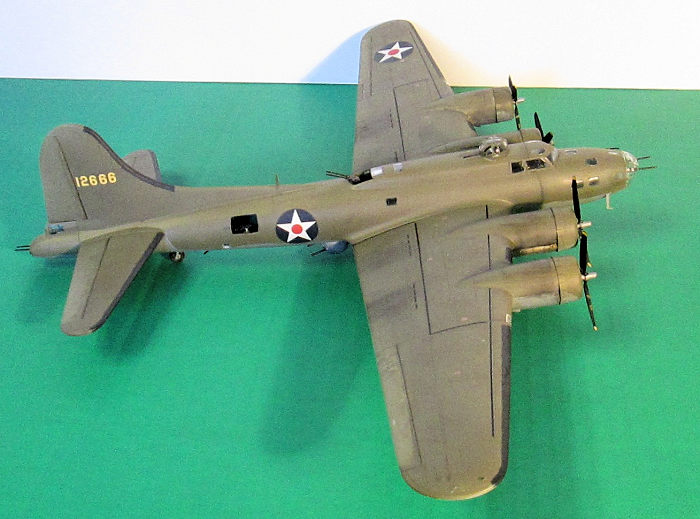 In successfully accomplishing this mission Old 666
returned to New Guinea badly shot up. Bombardier/nose gunner Joseph Sarnoski
(Medal of Honor) was killed, Jay Zeamer (Medal of Honor) was seriously wounded,
two more crew were less seriously wounded. The mission holds the distinction of
being the longest recorded running dogfight in Air Force history against an
estimated 17 Japanese Zeros.
In successfully accomplishing this mission Old 666
returned to New Guinea badly shot up. Bombardier/nose gunner Joseph Sarnoski
(Medal of Honor) was killed, Jay Zeamer (Medal of Honor) was seriously wounded,
two more crew were less seriously wounded. The mission holds the distinction of
being the longest recorded running dogfight in Air Force history against an
estimated 17 Japanese Zeros.
I was inspired by the story to model Old 666. In addition to the book I googled everything “B-17E Old 666” related. I found a few articles but they all conflict with one another and the book in some of the details. There are only two photos that exist confirmed to be of 12666. One shot from a distance, is of the airplane parked at a New Guinea airstrip, exact date unknown. The only details one can glean from this picture is the tail number and what appears to be some black lines on a wing at right angles that suggests the wing walk area striping is still there. The other is a shot of a different crew under the nose which is emblazoned with the name “Lucy” that is known to have adorned the aircraft at some period of its life. This close up crew photo, date unknown, offers little else in the way of details. There is a “Zeamer’s Eager Beavers” website which claims 43rd BG records describe 12666 as armed with 16 machineguns for the Bougainville mission as opposed to the book that states 17. I went with the 16 number as most likely. There is a good photo of B-17E 12627 which is the only other trimetragon camera equipped B-17E and luckily shows the locations of the camera windows. For the armament modifications I relied on the descriptions written in the book purportedly from interviews with Zeamer and other crew members. So the model is my interpretation of what she might have looked like. The accuracy of which is open to debate, which in itself can be quite entertaining.
| THE KIT |
Kit –
Packed In a large sturdy box are 8
individually wrapped sprues of light gray and clear plastic. Molding is of good
quality, no warping or sink marks. Engraving is petite but well defined and
overall accuracy appears to be good. Clear parts have some distortion in places
but are quite clear overall with sharp framing. Engines are nice with somewhat
oversize push-rod tubes. Interior is sparse as one might expect of this scale
and is designed to have the radio compartment canopy and waist windows closed,
precluding the need for much detailing. Cockpit is adequate having a deck,
seats, control columns, and instrument panel with a big decal that goes all the
way down to include throttle levers and such. You get decal seatbelts. Nose
compartment has the deck, navigator table, bomb sight and control panel, and
seats. Academy u ses the modular approach to these kits using common parts and
specialized sprues with the parts unique to that sub-type. The tail gun
compartment is a separate piece in clear plastic. The right waist-gun window
must be cut out and there are molded guides on the inside of the fuselage giving
the option of adjacent or staggered waist positions. There are a lot of unused
parts left over for your big box of junk. Instructions are a fold out sheet
divided into 8 construction steps. Not much in the way of written instruction
but the exploded drawings are adequate though vague in a couple of places. So
test fit everything first to be sure you get it. There is a 3-view showing
stencil and common marking placement and a page of side views for the 4 options
which are: Calamity Jane 11th BG, Yankee Diddler 43rd BG,
Yankee Doodle Jr 43rs BG, and a captured Japanese bird. The decal sheet is by
Cartograph and is the star of the show. Every conceivable stencil, full prop
markings including the yellow tips, bomb striping, even the wing tip navigation
lights. An excellent sheet.
ses the modular approach to these kits using common parts and
specialized sprues with the parts unique to that sub-type. The tail gun
compartment is a separate piece in clear plastic. The right waist-gun window
must be cut out and there are molded guides on the inside of the fuselage giving
the option of adjacent or staggered waist positions. There are a lot of unused
parts left over for your big box of junk. Instructions are a fold out sheet
divided into 8 construction steps. Not much in the way of written instruction
but the exploded drawings are adequate though vague in a couple of places. So
test fit everything first to be sure you get it. There is a 3-view showing
stencil and common marking placement and a page of side views for the 4 options
which are: Calamity Jane 11th BG, Yankee Diddler 43rd BG,
Yankee Doodle Jr 43rs BG, and a captured Japanese bird. The decal sheet is by
Cartograph and is the star of the show. Every conceivable stencil, full prop
markings including the yellow tips, bomb striping, even the wing tip navigation
lights. An excellent sheet.
| CONSTRUCTION |
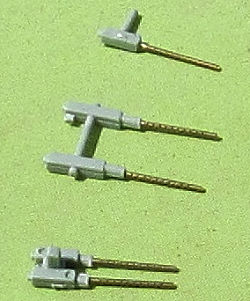 First was making the needed modifications.
The kit is intended to be built with the waist windows and radio compartment
hatches closed and the bomb bay doors opened. None of which I wanted. The
uniqueness of Old 666 is all those guns sticking out everywhere. The guns being
the focal point of this aircraft, I elected to spring for the Master Model metal
gun barrels. These are amazing little pieces of engineering with separate
barrel, perforated cooling jacket, and even some flash suppressors where needed.
So having previously built an F version Academy kit those extra parts became
invaluable in the form of the extra .50 machineguns I needed. The barrels are
cut off and a small hole drilled in the receiver to attach the Master barrels.
The guns were painted gun metal. The right waist window was cut out. I drilled
holes then cut out the camera windows below and behind the waist windows.
Luckily there is that great photo of the other B-17E recon bird showing this
window. Next was to determine where to mount Zeamer’s “snozzola gun.” Again, no
photos. The book simply states it was mounted forward of the cockpit and
attended to by the Navigator. So I drilled out a trough for the gun in a place I
thought likely. No idea how accurate this is. The radio compartment canopy was
cut to depict it in the open position. This exposed the fact there is no rear
bulkhead for the compartment. Again the extra Academy parts come to the rescue.
There are extra bulkhead parts that fit other B-17 marks. Some filing and
sanding to fit and its g
First was making the needed modifications.
The kit is intended to be built with the waist windows and radio compartment
hatches closed and the bomb bay doors opened. None of which I wanted. The
uniqueness of Old 666 is all those guns sticking out everywhere. The guns being
the focal point of this aircraft, I elected to spring for the Master Model metal
gun barrels. These are amazing little pieces of engineering with separate
barrel, perforated cooling jacket, and even some flash suppressors where needed.
So having previously built an F version Academy kit those extra parts became
invaluable in the form of the extra .50 machineguns I needed. The barrels are
cut off and a small hole drilled in the receiver to attach the Master barrels.
The guns were painted gun metal. The right waist window was cut out. I drilled
holes then cut out the camera windows below and behind the waist windows.
Luckily there is that great photo of the other B-17E recon bird showing this
window. Next was to determine where to mount Zeamer’s “snozzola gun.” Again, no
photos. The book simply states it was mounted forward of the cockpit and
attended to by the Navigator. So I drilled out a trough for the gun in a place I
thought likely. No idea how accurate this is. The radio compartment canopy was
cut to depict it in the open position. This exposed the fact there is no rear
bulkhead for the compartment. Again the extra Academy parts come to the rescue.
There are extra bulkhead parts that fit other B-17 marks. Some filing and
sanding to fit and its g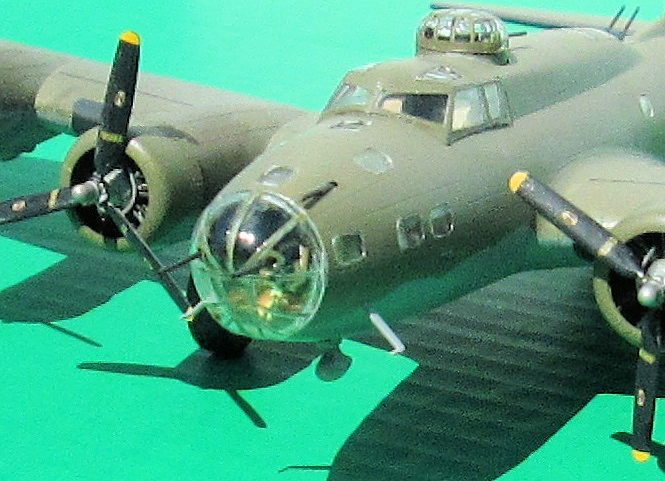 ood. I did not attempt extra interior detailing, but the
bulkhead was too obvious to leave out. Also described in the book was a manhole
sized opening cut in the floor in front of the tail wheel to mount more guns. I
glued on a couple small gadget looking things from the spares box to represent
the cameras blocking off those windows. Small scrap pieces were glued at the
radio compartment and hole in the floor to provide something to mount those guns
to. Next I glued on the bomb bay doors in the closed position. They are close,
but not really intended to be attached this way so test fitting, shaping, and
filling is required. The remainder of the kit was assembled as instructed.
ood. I did not attempt extra interior detailing, but the
bulkhead was too obvious to leave out. Also described in the book was a manhole
sized opening cut in the floor in front of the tail wheel to mount more guns. I
glued on a couple small gadget looking things from the spares box to represent
the cameras blocking off those windows. Small scrap pieces were glued at the
radio compartment and hole in the floor to provide something to mount those guns
to. Next I glued on the bomb bay doors in the closed position. They are close,
but not really intended to be attached this way so test fitting, shaping, and
filling is required. The remainder of the kit was assembled as instructed.
All of the small windows were glued in place except for the waist windows. The nose compartment and cockpit were assembled and all the insides painted interior green with black details here and there. The big instrument panel decal was applied and settled in place with Micro-Sol. The tail wheel strut glued in place and the upper and lower turret rings placed in their openings. The clear turret parts can be glued on later after painting. The Snozzola gun receiver was glued in place behind the opening. The barrel will be glued in place after painting. At this point the fuselage halves were glued together. The clear tail gun compartment was glued together and assembled to the fuselage. The cockpit canopy was masked and glued in place needing some filler. Likewise the radio compartment canopy.
The wings and landing gear were assembled as instructed and the tail planes attached. Fit in general is OK, but filler is needed in many areas with requisite sanding and some panel line re-scribing. That tail compartment seam was not good. All the little windows were masked with pieces of Tamiya tape then cut around the windows with a new hobby knife blade. The engine cowls were tacked on with a small drop of super glue. All openings were packed with wet tissue for painting.
| COLORS & MARKINGS |
E models were standard OD over Neutral Gray. I
pre-shaded panel lines flat black. I then airbrushed Model Master Acryl OD FS
34087 uppers. I masked the demarcation line and painted the lowers Model Master
Acryl Neutral Gray. I went over selected areas again with OD lightened with a
little Gray for some fading. When dry I hand painted the de-icer boots flat
black. The control surfaces were masked off and sprayed the OD lightened with
more Gray for some contrast. I used some black, gray, and red-brown pastels for
staining and some lightly done paint chipping with silver paint and a toothpick.
A black acrylic wash was applied to panel lines, cowl flaps, etc. So….here’s the
story. At the point of the war that 666 flew its epic
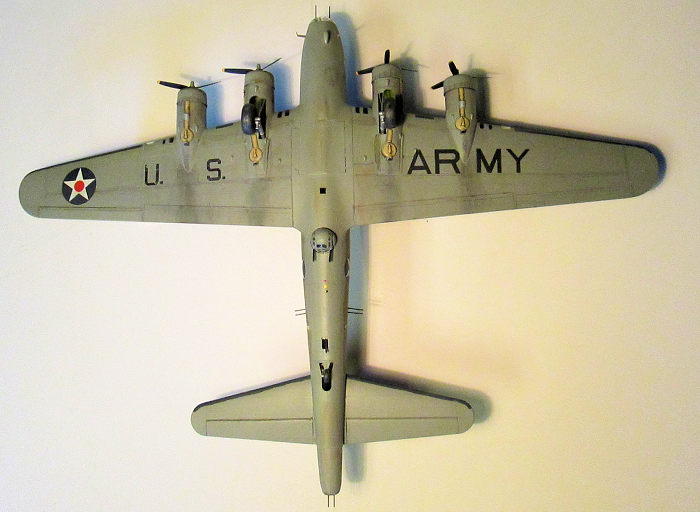 recon mission B-17Es were
old and war weary and had been replaced by Fs. But because of its unique camera mods 666 had been retained on active duty. 666 received extensive damage during
previous missions, requiring a complete wing transplant among other things. So
one might expect a very weathered and battle stained aircraft. But the chapter
in the book detailing the resurrection of 666 from the boneyard describes the
fresh coat of paint the aircraft received. Interesting is the fact that the red
meatball centers of the national insignia had been officially deleted at this
time, yet Zeamer chose to retain them for some reason during the re-painting.
That hazy photo of 666 previously mentioned shows what appears to be those black
wing walk area lines that were standard on 17Es and deleted on later models.
There is a photo of 666 flown by a different crew with the name “Lucy”
emblazoned on the nose. In an interview Zeamer insists there was no nose art on
the plane when the Eager Beavers crewed it. He said they were never on the
ground long enough to decorate it. So, the supposition on my part is that
Zeamer’s Eager Beavers began their exploits in April 1943 in a freshly painted
B-17E 12666 sporting the early marking scheme and bristling with machineguns (A
source cites the 65th Squadron morning report on the day of the
Bougainville mission listing 12666 carrying 16 .50 caliber MGs.) By the time of
the Bougainville mission in June the plane was no doubt exhibiting some signs of
wear. But I decided to take a light touch with the weathering. A coat of gloss
prepared the model for decaling. I used the kit national insignia with red
centers scrounged from the spares box. The Warbirds sheet provided the tail
numbers. The kit decals supplied the wing walk stripes and stenciling. (By the
way. Skip the kit’s wingtip navigation light decals and just paint them, much
easier). Another coat of gloss to seal it all up then finished with Testor’s
Clear Flat Acrylic. When dry all the masking was removed.
recon mission B-17Es were
old and war weary and had been replaced by Fs. But because of its unique camera mods 666 had been retained on active duty. 666 received extensive damage during
previous missions, requiring a complete wing transplant among other things. So
one might expect a very weathered and battle stained aircraft. But the chapter
in the book detailing the resurrection of 666 from the boneyard describes the
fresh coat of paint the aircraft received. Interesting is the fact that the red
meatball centers of the national insignia had been officially deleted at this
time, yet Zeamer chose to retain them for some reason during the re-painting.
That hazy photo of 666 previously mentioned shows what appears to be those black
wing walk area lines that were standard on 17Es and deleted on later models.
There is a photo of 666 flown by a different crew with the name “Lucy”
emblazoned on the nose. In an interview Zeamer insists there was no nose art on
the plane when the Eager Beavers crewed it. He said they were never on the
ground long enough to decorate it. So, the supposition on my part is that
Zeamer’s Eager Beavers began their exploits in April 1943 in a freshly painted
B-17E 12666 sporting the early marking scheme and bristling with machineguns (A
source cites the 65th Squadron morning report on the day of the
Bougainville mission listing 12666 carrying 16 .50 caliber MGs.) By the time of
the Bougainville mission in June the plane was no doubt exhibiting some signs of
wear. But I decided to take a light touch with the weathering. A coat of gloss
prepared the model for decaling. I used the kit national insignia with red
centers scrounged from the spares box. The Warbirds sheet provided the tail
numbers. The kit decals supplied the wing walk stripes and stenciling. (By the
way. Skip the kit’s wingtip navigation light decals and just paint them, much
easier). Another coat of gloss to seal it all up then finished with Testor’s
Clear Flat Acrylic. When dry all the masking was removed.
| FINAL CONSTRUCTION |
The engines were built and painted. The cowls were removed, the engines inserted then assembled to the nacelles. The gear struts were painted then the wheels assembled and painted. The turbo-chargers and piping were painted a flat tan and glued in place. The upper and lower turret glazing framework was a combination of hand painting and decal strips. I used strips of decal for the nose fairing framework. The turrets were assembled and glued onto their rings. The tail gun barrels were glued into holes drilled for them. The twin MGs were glued in place in radio compartment and waist positions. A .50 was glued to the belly position.
 Now the nose guns presented
me a bit of a dilemma. The book describes two .50s replacing the nose .30s and
the Academy nose fairing has two holes to accommodate the guns. All very neat,
but the book describes another gun operated by the Navigator that would make the
number of guns too high and the 17E did not have the gun windows that would
appear in the F to accommodate Navigator operated guns. Researching everything I
could find on this subject did expose me to an uncomfortable possibility. There
are photos of B-17Es (the ones I found were European Theater) apparently field
modded with 17F gun windows in the nose. As the Fs came into use it is plausible
this was a common field mod. But, since there is no photo evidence, and doing
this would require building an F model kit with an E nose fairing, I decided to
just go the easy route and stuck the two guns in the nose cap. Is it correct?
Not sure, but one of those things that modelers can gab about forever.
Now the nose guns presented
me a bit of a dilemma. The book describes two .50s replacing the nose .30s and
the Academy nose fairing has two holes to accommodate the guns. All very neat,
but the book describes another gun operated by the Navigator that would make the
number of guns too high and the 17E did not have the gun windows that would
appear in the F to accommodate Navigator operated guns. Researching everything I
could find on this subject did expose me to an uncomfortable possibility. There
are photos of B-17Es (the ones I found were European Theater) apparently field
modded with 17F gun windows in the nose. As the Fs came into use it is plausible
this was a common field mod. But, since there is no photo evidence, and doing
this would require building an F model kit with an E nose fairing, I decided to
just go the easy route and stuck the two guns in the nose cap. Is it correct?
Not sure, but one of those things that modelers can gab about forever.
| CONCLUSIONS |
The Academy 1-72 B-17 series have been around a long time. They certainly have their faults and personally I find the old Revell 17s, though less detailed and refined, a more enjoyable build. The modular approach requiring one to cut out windows can make this kit a bit intimidating for the novice builder. That said they do make up into good replicas of the type. As to this representation of 12666, it is my interpretation of this historical aircraft based mostly on verbal descriptions. I don’t claim it to be definitive.
| REFERENCES |
Lucky 666, Bob Drury and Tom Clavin, Simon and Schuster 2016.
Internet: Zeamer’s eager beavers.com, Pacific Wrecks.com
24 September 2018
Copyright ModelingMadness.com
If you would like your product reviewed fairly and fairly quickly, please contact the editor or see other details in the Note to Contributors.
Back to the Main Page Back to the Review Index Page Back to the Previews Index Page